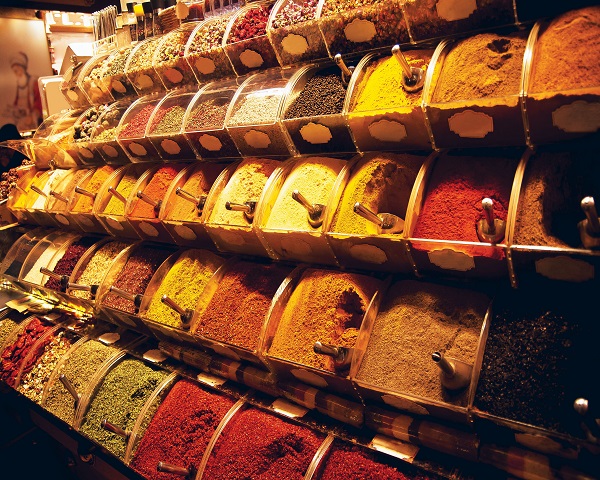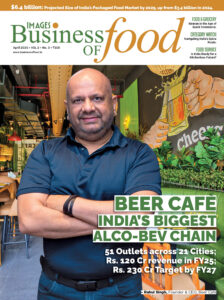In the market of spices, one man embarked on a journey that would redefine his career and leave an indelible mark on the industry. Meet Adesh Kumar Aggarwal, affectionately known as the “Masala Man,” whose odyssey into the world of spices offers a rich storybook of insights and lessons in how the retail spice sector works.
From figuring out what spices people like in different regions to coming up with new and clever ways to sell them, Adesh’s voyage illuminates the complexities and opportunities inherent in the spice trade. Let’s dive in and learn more about the Masala Man’s experiences and what they teach us about the spice market in India.
Imagine stepping onto a ship and embarking on a journey into the vast and tumultuous seas of the spice trade. That’s exactly what Adesh Kumar Aggarwal experienced when he was put in charge of the spice section at India’s biggest food and grocery retail chain around late 2014.
Like a seasoned captain guiding a ship through the seas, Adesh had charted courses through the retail market since the dawn of his career in 2004. Yet, the spice sector was a distant shore, unfamiliar and daunting. Stepping into the spice business, Adesh felt uncertain, like a sailor setting foot on an unknown island. The spice category, a labyrinth of flavors and fragrances, looked as intricate as a complex puzzle. Each region, a new chapterin the epic saga of taste, told stories of garam masalas and blends as diverse as the colors of India itself.
“Entering the spices category was like diving into uncharted waters for me. Despite years of experience handling various categories including food, non-food, automotive, apparel, and consumer durables, I had never handled any responsibility within the spices trade. I felt quite lost in managing a category that is notoriously challenging due to diverse preferences and regional variations in taste,” recounts Adesh.
Retail experts acknowledge that the spice category is quite complex, with a wide range of needs and preferences across the country. Even within one State, these preferences can vary every 50-100 kilometers. For example, in Maharashtra, the requirements for garam masala in Vidarbha differ from those in Mumbai or the nearby southern states.
Each region has its own unique blend preferences and nuanced taste profiles, besides the proliferation of myriad small-scale players operating from local towns. Their products get prominently displayed on store shelves, showcasing the rich culinary traditions loved by different communities in different parts the country. These variations highlight the complexity of managing the spices category and the importance of understanding and adapting to consumer preferences.
Faced with this complex reality, Adesh found himself at the crossroads of tradition and innovation, where the wisdom of generations clashed with the winds of change. Thankfully, that initial feeling of having hit the chicane did not last long. Within a few months of being given the responsibility, he was able to find a mentor outside the organization who taught him the alchemy of quality and the secrets of blends.
Gradually, his interest in the category grew and like a spice merchant of old, his professional sails caught the winds of understanding, propelling him forward into the heart of the spice market. “As time passed, my fascination with the category grew, and I became deeply engaged with it to the point where it became an integral part of my identity,” recalls Adesh.
As the seasons turned, so did Adesh’s journey. From the uncertainty of uncharted waters emerged a captain, resolute and seasoned. His passion for spices, once a flickering flame, now burned as brightly as the Indian sun. Through dedication and diligence, he transformed challenges into opportunities, navigating the currents of consumer preference with the skill of a master mariner.
Mastering Spice Supply Chains
His first task was to address supply chain management issues, which presented significant challenges. The spices industry revealed itself as a mosaic of small-scale enterprises scattered like gems across the land. Each town birthed its own blend, its own story, weaving a maze of complexity that tested Adesh’s resolve.
He discovered the challenges of navigating through the abundance of local assortment and the presence of numerous localized products, alongside the somewhat disorganized nature of brands and businesses in the sector, all of which collectively contributed to the challenge of effectively managing the supply chain.
“One of the key learnings in this industry is the importance of addressing supply chain challenges and managing assortments effectively. This is not just a concern for one organization but for all retailers. In a single State alone, managing the diverse range of variants, brand preferences, and tastes requires handling a minimum of 500 to 600 unique product lines. To cater to the preferences of consumers across India, a minimum assortment of 15,000 to 20,000 unique SKUs is necessary. This extensive assortment is essential because tastes and preferences vary greatly even within short distances.” Managing these challenges requires a thorough grasp of customer preferences and the ability to fulfill their needs consistently. The category demands a genuine passion because it entails intricate merchandising strategies tailored to diverse regional preferences. It demands a perpetual cycle of learning, adjusting, and putting new insights into action.
“Effective merchandising in the spices category demands a nuanced understanding of each region’s preferences and necessitates dedicated ground-level engagement to inform strategic decisions. For instance, in the southern regions, prioritizing non-vegetarian masalas may yield different results compared to the north where garam masala and kitchen king masala dominate. The dynamics shift further when considering preferences for vegetable masalas,” explains Adesh.
Like a craftsman honing his skills, Adesh implemented his learnings with precision, molding the rough clay of systems and processes into refined tools of efficiency. “I began implementing what I learned on the ground and kept pushing to make our systems and processes better. It led to continuous improvement in our product quality and performance year after year. This hands-on approach helped me understand the intricacies of the spices category and contributed to my professional growth,” admits Adesh.
Another essential aspect of supply chain management revolves around achieving optimal fill rates. Maintaining fill rates of at least 90-96% is crucial for sustaining business momentum and fostering growth. “Ensuring product availability emerges as a critical concern upon entering this category. Collaborating closely with the team, we identified and addressed various issues, continuously refining our processes while meticulously monitoring fill rates and the timelines of brand deliveries. These efforts have been integral to our journey towards operational excellence and sustainable growth,” says Adesh.
Game-Changing Initiatives
In addition to his efforts in strengthening the supply chain for greater adaptability and durability, Adesh spearheaded a series of other initiatives aimed at expanding the category and accelerating business growth. In one such instance, he and his team collaborated closely with their brand partners to introduce the concept of share bags within the Chinese masala range.
Share bags are large packs of a product that contain multiple servings. These bags offer convenience and value to consumers by providing a larger quantity of the product at a competitive price compared to purchasing individual servings.
“These share bags have transformed the industry by providing customers with a variety of options in a single package, effectively catering to multiple preferences. This initiative, previously absent in the spices sector, significantly boosted growth in specific segments by offering convenience and choice like never before,” informs Adesh.
Building on this success, Adesh and team extended similar practices to the seasoning category. By packaging products in convenient formats, such as share bags, they witnessed a remarkable shift in consumer demand. “These user-friendly packs not only enhance convenience but also provide multiple touch points within stores, contributing to the segment’s growth,” notes Adesh.
Other notable initiatives included introducing consumer-centric promotions to further drive engagement. “Our ‘buy any 2 get any 1’ offer, launched in 2018, marked a significant departure from traditional promotions. This inclusive offer applied to all brands and products under one roof, generating widespread attention and sparking conversations within the industry. Despite initial skepticism, this disruptive offer garnered widespread adoption, even by international retailers, cementing its status as a game-changer,” asserts Adesh.
While implementing such initiatives comes with its challenges, including price and margin considerations and brand restrictions, Adesh and team have remained steadfast in their commitment to delivering value to customers. During key festive periods like Holi, Diwali, and Independence Day, they have continued to roll out special promotions, which consistently spark consumer interest and anticipation.
Industry Recognition
These significant initiatives marked out Adesh with a unique recognition in the industry, earning him the moniker of “Masala Man.” Reflecting on the title, Adesh shares how over the past five to six years in the spice industry, he has noticed a shift in how he’s perceived within the trade community. “When I go to a trade fair, exhibition, or an industry event, people and even those who are complete strangers greet me as ‘Masala Man’, and I wear this badge of honor with pride, for it signifies my profound connection to the industry I serve.”
Although some may find amusement when he includes the title in his LinkedIn profile, it has become more than just a label for Adesh. Instead, it has evolved into his defining identity, elevating him to a stature that goes beyond ordinary professional acknowledgment.
Trends in the Spice Market and Consumption Patterns
Commenting on the current spice retail market in India, the Masala Man says that over the past decade, the Indian spices industry has undergone remarkable changes. “In the retail sector, the spice industry has seen tremendous growth, with a remarkable annual increase of 20-25% in both the amount of spices sold and their overall value. This growth rate is much higher compared to the compound annual growth rate (CAGR), which measures average annual growth over a period of time. So, while the overall spice industry is growing steadily, the retail side of the business is growing much faster, expanding by 20-25% each year.”
He says that every region have their own different leading brands. These brands often hold leading positions in their respective regions, reflecting the diverse preferences across different parts of the country. “Nationally, only 2-3 brands maintain a presence across multiple states, yet the majority of their business – 60% to 70% – and consumer acceptance remains concentrated within their primary markets.”
Citing a few examples, he points out that in Chennai, Acchi spices reigns supreme, while MDH holds sway in Delhi-NCR and northern regions. Similarly, Suhana and Everest enjoy prominence in Mumbai and Maharashtra, owing to their decades-long legacy.

When discussing spice segments and consumption patterns, the Masala Man says the spices category can be broken down into several segments. Firstly, there are powdered spices such as chili, turmeric, and coriander, which constitute one segment. Then, there are blended spices like chicken masala and meat masala, as well as seasoning options like oregano and newer products like Ching’s Secret Masala range, which form an additional segment. He observes that although pure spices and blended spices dominate the industry, accounting for over 90% of the market, other segments like whole spices also play a significant role. “In modern retail, the emphasis is on whole spices, followed by powdered
spices and blended spices, which are the primary segments. Additionally, there are minor segments like hing and emerging products like Chinese masala and Maggi Magic Masala, which are steadily gaining traction and evolving year by year. Also, I’ve observed significant growth in the blended masala segment, making it one of the fastest-growing categories.”
He mentions that certain product categories exhibit consistent popularity nationwide, with garam masala and chicken masala emerging as top sellers. However, some interesting shifts have taken place, such as the growing demand for sambhar masala in northern states, which is indicative of evolving culinary preferences.
Noting that every state and region within the country showcases unique flavor preferences, he offers examples of blends like kanda-laisun masala in Maharashtra and kitchen king pav bhaji in the north enjoying widespread popularity. “Garam masala, chicken masala, meat masala, sambar masala, paneer masala, chole masala, and rajma masala are among the top preferred blends, and reflect the rich tapestry of culinary traditions across India.”
Commenting on some of the more spectacular product launches in the Indian market, Adesh talks about a remarkable product launch in the Indian market about ten years ago: Maggi Magic Masala. When it first came out, many people in the industry were doubtful about its success and questioned its purpose. However, over time, Magic Masala defied expectations and emerged as a standout performer in the blended spices category, capturing a significant market share.
“Today, Magic Masala’s widespread availability is evident even in small towns and villages like Palwal in Haryana and Zikar in Rajasthan. Its success has prompted not only established brands but also emerging ones to develop similar products, which is evidence of the significant impact it has had on consumer preferences.”
Similarly, the Chinese masala segment, pioneered by Chings over the past decade and a half, continues to experience sustained growth. This trend is driven by the increasing demand for Chinese cuisine among households, leading to the introduction of innovative products like Soyabadi masala, a relatively recent addition to the market developed by Capital Food.
Other examples include GM Foods’ Aloo Sabji Masala, which has gained widespread acceptance in the Delhi-NCR region due to its exceptional taste. These success stories underscore the continuous learning and collaboration between retailers and brands to identify gaps in the market and develop products that resonate with consumers’ preferences.
Regarding the popular price points, Adesh observes that there exists diverse consumer behaviors based on socio-economic profiles. Some buyers, such as daily wage earners, typically purchase smaller packs priced at Rs. 5 or Rs. 10 from local markets. These packs are meant for one or two-time use, and are convenient for consumers who earn and spend on a daily basis.
Conversely, middle-class and upper-middle-class consumers opt for larger pack sizes, typically around 100 grams, which suffice for monthly consumption in their households. For staples like chili and turmeric, the monthly consumption ranges from 200 to 300 grams. Among the popular pack sizes, the 100-gram pack is favored for blended spices, while smaller 50-gram packs are preferred for specialty items like tea masala, which tend to be relatively pricier. “The preference for pack sizes is influenced by both affordability and consumption patterns,” notes Adesh.
Opportunities in Spice Categories and Room for Innovation
When discussing opportunities and scope for innovation, Adesh emphasizes that the spice category stands out as a promising frontier, teeming with opportunities yet to be explored. “Understanding consumer preferences and conducting trials play pivotal roles in uncovering these opportunities, as evidenced by past successes like the introduction of Soya Badi masala and Aloo Sabji masala.”
He suggests that spices, being complementary to a wide array of dishes, offer ample opportunities for brands and manufacturers to introduce innovative products that enhance flavor profiles and elevate culinary experiences. For example, the introduction of Soya Badi masala prompted consumers to prefer it over plain alternatives. Similarly, the launch of Aloo Sabji masala revolutionized home cooking by offering convenience and enhancing the taste of staple dishes like potato curry. “New products that offer enhanced convenience and superior taste experience are likely to attract their own dedicated market,” opines Adesh.
The Masala Man believes that developing new products in the spices segment is relatively straightforward once you grasp consumer tastes and blend them with the right processes. Explaining that continual innovation on the part of brands and manufacturers will stem from engaging with consumers, visiting stores, and observing market trends, he highlights the importance of recognizing unmet needs and adapting offerings accordingly to drive product development.
“The blended spices segment particularly stands out due to its potential for innovation and the creation of new products, making it a fertile ground for new opportunities and continued growth,” points out Adesh,
adding that unlike single and straight powders such as chili, turmeric, or coriander, which are considered commodities, blended spices offer many possibilities for creativity and precision in formulation. “The future of the spices industry lies in the expansion of blended spices, alongside other growing segments like seasonings. While not on the same scale as blended spices, seasoning products will also contribute to the overall growth of the spices sector.”
He also makes an interesting observation regarding the untapped potential in the paneer masala segment within the blended spices category. Despite higher sales in Maharashtra and Mumbai, there’s room for growth, especially if leading brands expand their offerings to encompass a broader range of paneer-based cuisines. By catering to diverse regional tastes, this segment holds promise for further expansion, says Adesh.
He illustrates his point with an example. Restaurants offering multiple paneer dishes inspired the creation of a range of paneer masalas by Suhana. This move not only catered to different preferences, it also significantly enhanced sales of paneer masala in Mumbai and Maharashtra.
Adesh also refers to a current trend where more individuals are choosing restaurant food over home- cooked meals. This inclination stems from a desire for diverse culinary experiences and a lack of time or culinary skills for home cooking.
To leverage this trend, Adesh suggests that brands can introduce solutions like ready-to-use spice mixes and biryani kits that provide consumers with convenient options to replicate restaurant flavors at home. “While these solutions provide a convenient way to recreate restaurant flavors at home, the increasing availability and popularity of ready-to-use spice mixes are anticipated to drive growth in the spices category.”
Reiterating the significance of recognizing market gaps and devising solutions that resonate with consumer preferences, Adesh cites the example of Palak Paneer masala, which not only helped to boost the dish’s consumption but also to enhance its flavor profile, thereby addressing an unmet demand in the market.
The Masala Man also strongly advocates for innovation to extend beyond familiar dishes like biryani. “The introduction of biryani masala has simplified the cooking processes and enhanced convenience for consumers. Similarly, the availability of specialized blends for dishes like lemon rice reflects a deep understanding of regional preferences and culinary practices.”
Anticipating a promising future for the spice category in India, Adesh highlights the growing enthusiasm among major companies and brands towards this segment. “It’s fascinating to observe this heightened interest, which indicates a significant shift towards innovation within the industry. Unlike in the past, when brands relied on outside suggestions for product development, they are now taking proactive steps to identify opportunities and create new offerings that better align with consumer needs.”
This shift is quite remarkable and demonstrates a growing awareness among national and top-tier brands about the potential in the spices market and the room for innovation. “Whenever I engage with individuals discussing innovation and product development, it’s inspiring to witness the enthusiasm surrounding the evolution of this category. The fact that brands are proactively exploring avenues for innovation in spices is indeed a positive development,” remarks Adesh.
Market Dynamics and Profitability
The spice category boasts profit margins ranging from 21% to 30%, which is substantially higher than margins seen in other FMCG sectors, says the Masala Man. “This high profitability will drive both brands and retailers to remain increasingly invested in the spice sector, recognizing its potential for consistent growth year after year.”
Elaborating on the profitability aspect of the spice category, Adesh alludes to the practice of big brands buying up smaller ones. But here’s the twist: even though big brands swallow up the small ones, it doesn’t really shake things up for the little guys. Why? Because these small brands often have something special – maybe it’s a secret recipe or loyal customers who love their spices. So, even if a big brand takes over, those loyal customers stick around.
“Over the past decade, I haven’t noticed any major impact on the business volumes or models of these local brands due to such acquisitions. This trend of acquisitions is common across various sectors, but it doesn’t pose a significant threat to the existence or growth of smaller spices manufacturers and brands,” says Adesh.
For instance, he points to brands like Pote Masala in Panvel, Mumbai, which enjoys strong local loyalty and continues to thrive despite larger acquisitions in the market. “Local players have their own niche and customer base, which often remains loyal to them despite changes in ownership. So, even if a big brand like ITC acquires another leading brand like Sunrise in West Bengal, it doesn’t usually disrupt the market dynamics for smaller players.”
Wrapping up his observations, the Masala Man says that the spice market in India is set to witness a surge in innovation and the introduction of many new novelty products in the years to come. “Expect to see the launch of numerous new recipe-based spice products, varied pack sizes, and adjustments in blends and flavors.”




